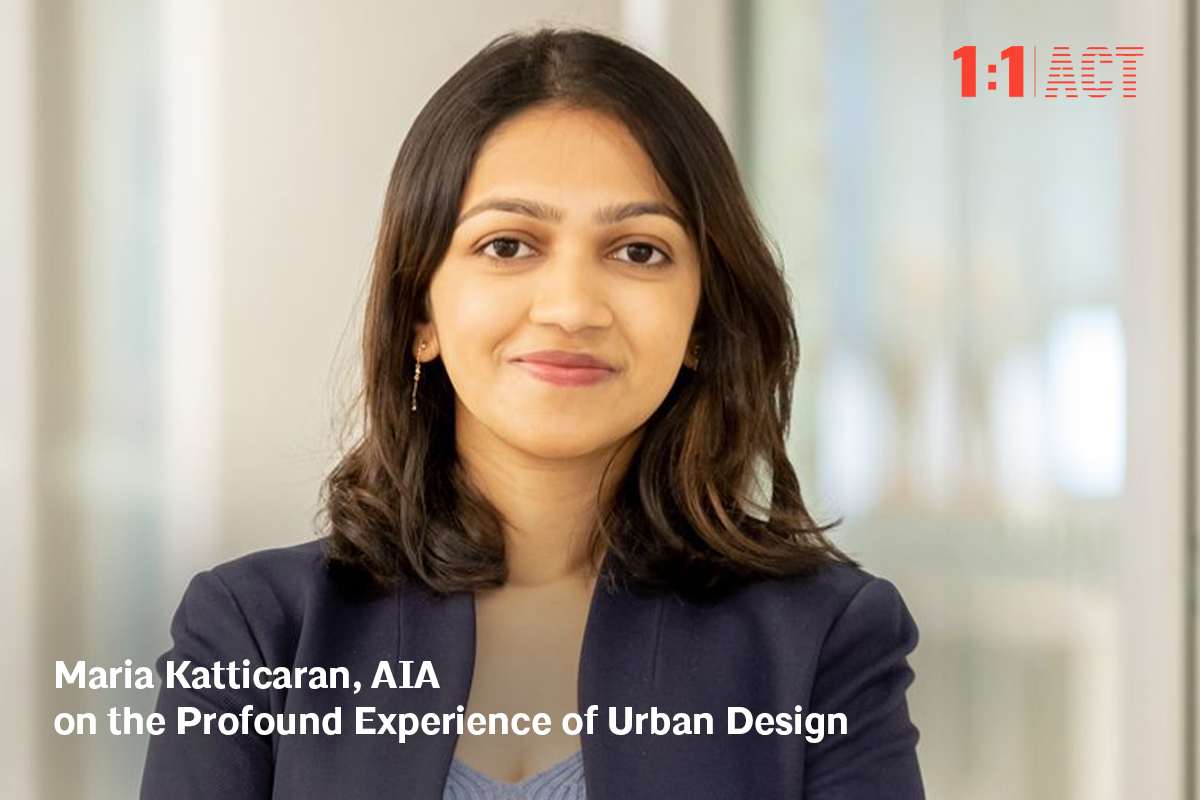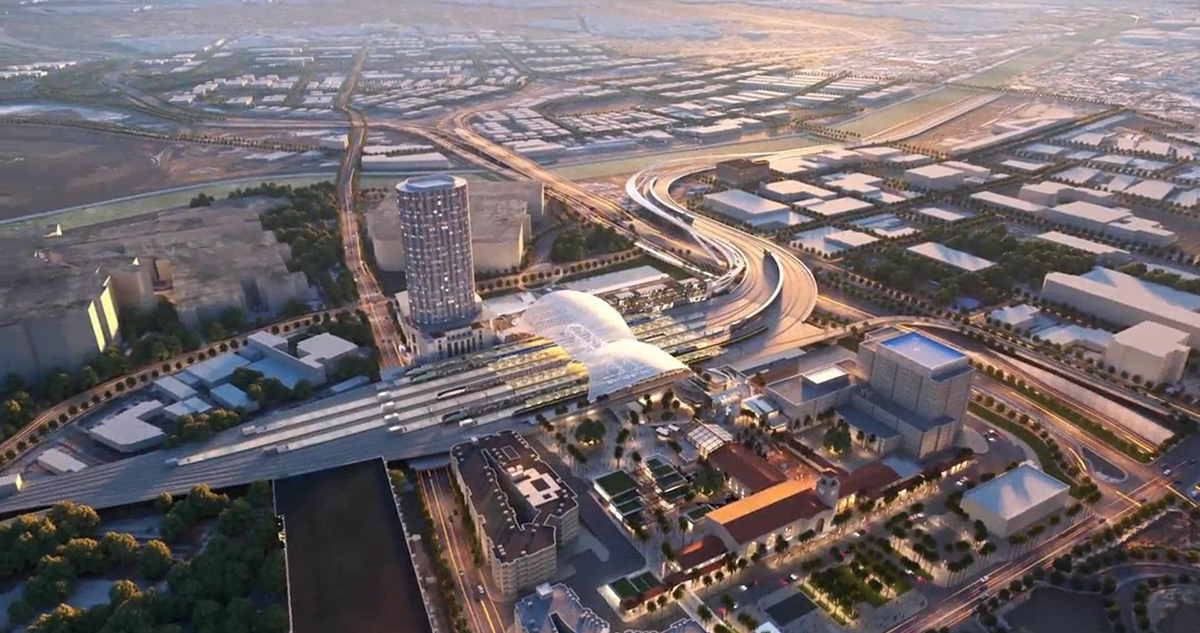
As the United States rekindles its interest in public transportation, particularly rail lines, and concurrently re-elevates urban space, it would do well to turn to those with experience in other countries. This 1:1 Act features AIA CA Urban Design Committee member Maria Katticaran, AIA, who grew up in Kerala, India, and, on this side of the globe has helped shape multibillion-dollar projects such as Union Station in Los Angeles, California and Ontario Line in Toronto, Canada.
An architect and urban designer at HDR, Katticaran also uses her experience beyond her day job: she serves on the San Francisco Bay Restoration Authority’s Advisory Board and the City of Oakland’s Landmarks Preservation Advisory Board. With her talk at the AIA Knowledge Community’s Regional & Urban Design Symposium coming up in October, we thought it would be a good time to discover how her background led her to Urban Design, the work of the Bay Restoration Authority, and more.

AIA California: Why were you inspired to focus on Urban Design in your practice? And what are one or two of your key achievements in the area?
Maria Katticaran, AIA: I grew up in Kerala, India, surrounded by a rich tapestry of cultural vibrancy, community ties, and intricate human interactions. More than buildings, I have always been drawn to the spaces between them. The traditional courtyards, the bustling markets, and the festivals that turned streets into stages were the arenas of genuine human connection. I was inspired by the art and science of fostering such interactions, creating spaces that encourage community building, and shaping cities that are not just functional but also deeply rooted in their cultural contexts. Urban design is about ensuring that as cities grow and evolve, they retain the human stories that make them unique.
I’ve had the privilege to contribute to transformative projects that would reshape cities and impact the daily lives of millions. My most profound experience was working on the reimagining of the Los Angeles Union Station (LINK US). This mega project was not just about redesigning a transport hub; it was about redefining the urban fabric of the City of Los Angeles. The project’s multidimensional approach, encompassing urban design principles, sustainability, and modern infrastructure, aimed to seamlessly integrate transportation modes and foster vibrant public spaces. Another significant undertaking was my involvement in the urban design and station architecture for the multibillion-dollar Ontario Line in Toronto. The challenge was to design stations that would facilitate efficient movement and enhance the urban environment around them.
“I've had the privilege to contribute to transformative projects that would reshape cities and impact the daily lives of millions.”

Through these projects, I’ve learned the profound impact urban design can have on shaping cities, fostering communities, and enhancing the quality of life for their inhabitants. I remain committed to leveraging design as a tool for positive urban transformation.
AIA CA: You are a panelist at this October’s “Cities in Transition: Designing for A World in Flux.” How is California leading in the areas the conference will address? What do we need to change?
MK: California has always been at the forefront of innovative solutions, and its approach to climate resiliency is no exception. Our waterfronts, often bustling hubs of commerce, culture, and community, are also the most susceptible to the adverse effects of climate change. Rather than solely relying on top-down models, California has embraced a participatory approach, placing frontline communities at the heart of building resilient solutions. The rationale is clear: those who live and work by the water have an intimate knowledge of its ebbs and flows, making them invaluable stakeholders in any waterfront planning initiative.
The success stories are numerous. From community workshops to collaborative design sessions, we’ve witnessed how a diverse coalition of stakeholders – residents, local businesses, and environmental experts – can craft innovative and sustainable solutions. These solutions address immediate concerns and lay the groundwork for long-term resilience, ensuring our waterfronts remain vibrant and adaptive in the face of future challenges.
“As architects and designers, our work is most impactful when it resonates with the aspirations, needs, and histories of the communities we serve.”

However, while we’ve made significant strides, more work must be done. The urgency of our climate crisis demands that we continuously reassess and refine our approaches. We must ensure our participatory methods are genuinely inclusive, capturing our communities’ diverse voices and concerns. We need to strengthen communication channels between policymakers, designers, and community members, creating a feedback loop that allows us to adapt and evolve our strategies in real time.
AIA CA: You’re on the advisory committee for the San Francisco Bay Restoration Authority. How is your work of this committee influencing you as an architect and urban designer?
Serving on the advisory committee for the San Francisco Bay Restoration Authority has been a transformative experience that has profoundly influenced my perspective as an architect and urban designer. The intersection of ecological restoration, community engagement, and urban development presents a complex and ever-evolving landscape of challenges and opportunities.
The San Francisco Bay, with its vast expanse and ecological significance, is a testament to the delicate balance between human habitation and environmental stewardship. Being part of the Restoration Authority has honed my understanding of this balance. I’ve come to appreciate that every architectural and urban design decision we make, no matter how minute, has ripple effects on the broader ecosystem. This realization has deepened my commitment to sustainable and environmentally conscious design practices.
The collaborative nature of the committee has reinforced the importance of multidisciplinary approaches in urban design. This holistic view has become a cornerstone of my design philosophy. As architects and designers, our work is most impactful when it resonates with the aspirations, needs, and histories of the communities we serve. My involvement with the Authority has fortified my belief in participatory design processes, ensuring that the voices of those directly affected by our decisions are central to the design narrative.
AIA CA: How do you balance your commitments to practice and volunteer positions?
MK: For me, the key lies in understanding that both spheres, while distinct, deeply complement and enrich each other. Instead of viewing my practice and volunteer positions as separate entities, I try to find the overlaps and synergies between them. This integration allows me to bring insights from my professional practice into my volunteer work and vice versa. It becomes manageable and immensely rewarding when approached with clarity, passion, and a spirit of collaboration. Both realms offer unique opportunities for growth, impact, and fulfillment. I am grateful to contribute and learn in such diverse settings. Moreover, my community work has always been greatly appreciated and supported by my employer, HDR.
AIA CA: What’s the most important thing about architecture?
MK: The most important thing about architecture is its profound ability to shape and influence human behavior and interactions. Architecture is not just about constructing buildings; it’s about creating spaces that dictate how we relate to one another.
During my undergraduate program in India, I embarked on an academic project that offered deep insights into this very aspect. I compared two distinct multi-family housing typologies I had lived in, aiming to discern the effects of their design on the interactions and familiarity among neighbors. The outcome was revelatory. The study illuminated the immense power of architectural design in promoting or inhibiting community interactions and fostering camaraderie. This realization was not just academic but deeply personal, and it underscored a fundamental truth I had experienced firsthand: the spaces we inhabit profoundly shape our communal experiences. This understanding is something I will cherish and utilize throughout my architectural journey, ensuring that every design choice I make is imbued with the potential to nurture and strengthen human connections.